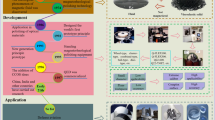Abstract
This paper analytically develops a type of model for predicting material removal depth in large mould polishing with coated abrasives. This model based on the statistical theory, and the abrasive material surface contact mechanics is established. The material removal depth is calculated by integrating the linear removal intensity or the removal depth per unit time along the polishing path. The material removal depth profiles of the circular abrasive tool and the annular abrasive tool are presented when polishing paths are a straight line and a curve, respectively. The effects of process parameters on the material removal depth are simulated and analyzed, such as polishing pressure, feed rate, tool speed, and internal radius, when the polishing path is a straight line. The workpiece surfaces after milling were polished by using annular abrasive tool moving along a straight line in the experiment. This model is evaluated by comparing the theoretical material removal depth with those experimental results available. It is concluded that the experiment results are approximately consistent with the model predictions.
Similar content being viewed by others
References
Yang Z, Chen F, Zhao J, Wu X (2009) A novel vision localization method of automated micro-polishing robot. J Bionic Eng 6(1):46–54
Tsai M, Huang J, Kao W (2009) Robotic polishing of precision molds with uniform material removal control. Int J Mach Tools Manuf 49:885–895
Guo HR, Wu YB, Lu D, Fujimoto M, Nomura M (2014) Effects of pressure and shear stress on material removal rate in ultra-fine polishing of optical glass with magnetic compound fluid slurry. J Mater Process Technol 214(11):2759–2769
Dong ZC, Cheng HB (2014) Study on removal mechanism and removal characters for SiC and fused silica by fixed abrasive diamond pellets. Int J Mach Tools Manuf 85:1–13
Guo J, Suzuki H, Higuchi T (2013) Development of micro polishing system using a magnetostrictive vibrating polisher. Precis Eng 37:81–87
Liu XY, Liu YL, Liang Y, Zhao ZW, Gao BH (2012) Kinetics model incorporating both the chemical and mechanical effects on material removal for copper chemical mechanical polishing. Microelectron Eng 91:19–23
Lin ZC, Huang WS, Tsai JS (2012) A study of material removal amount of sapphire wafer in application of chemical mechanical polishing with different polishing pads. J Mech Sci Technol 26(8):2353–2364
Cheung CF, Kong LB, Ho LT, To S (2011) Modeling and simulation of structure surface generation using computer controlled ultra-precision polishing. Precis Eng 35:574–590
Kim S, Saka N, Chun JH (2014) The effect of pad-asperity curvature on material removal rate in chemical-mechanical polishing. Procedia CIRP 14:42–47
Lin ZC, Wang RY (2014) Abrasive removal depth for polishing a sapphire wafer by a cross-patterned polishing pad with different abrasive particle sizes. Int J Adv Manuf Technol 74(1–4):25–36
Lee HS, Jeong HD, Dornfeld DA (2013) Semi-empirical material removal rate distribution model for SiO2 chemical mechanical polishing (CMP) processes. Precis Eng 37:483–490
Jin XL, Zhang LC (2012) A statistical model for material removal prediction in polishing. Wear 274–275:203–211
Chen XC, Zhao YW, Wang YG (2012) Modeling the effects of particle deformation in chemical mechanical polishing. Appl Surf Sci 258(22):8469–8474
Wang GL, Wang YQ, Xu ZX (2009) Modeling and analysis of the material removal depth for stone polishing. J Mater Process Technol 209:2453–2463
Lin TR (2007) An analytical model of the material removal rate between elastic and elastic-plastic deformation for a polishing process. Int J Adv Manuf Technol 32(7–8):675–681
Fan C, Zhao J, Zhang L, Wong YS, Hong GS, Zhou WS (2014) Modeling and analysis of the material removal profile for free abrasive polishing with sub-aperture pad. J Mater Process Technol 214:285–294
Feng DY, Sun YW, Du HP (2014) Investigations on the automatic precision polishing of curved surfaces using a five-axis machining centre. Int J Adv Manuf Technol 72(9–12):1625–1637
Chen Y, Nguyen T, Zhang LC (2009) Polishing of polycrystalline diamond by the technique of dynamic friction—Part 5: quantitative analysis of material removal. Int J Mach Tools Manuf 49:515–520
Zeng SY, Blunt L (2014) Experimental investigation and analytical modelling of the effects of process parameters on material removal rate for bonnet polishing of cobalt chrome alloy. Precis Eng 38:348–355
Zeng S, Blunt L (2014) An experimental study on the correlation of polishing force and material removal for bonnet polishing of cobalt chrome alloy. Int J Adv Manuf Technol 73(1–4):185–193
Pan GS, Wang N, Gong H, Liu Y (2012) An empirical approach to explain the material removal rate for copper chemical mechanical polishing. Tribol Int 47:142–144
Klocke F, Zunke R (2009) Removal mechanisms in polishing of silicon based advanced ceramics. CIRP Annals-Manufacturing Technology 58:491–494
Atkins AG, Liu JH (2007) Toughness and the transition between cutting and rubbing in abrasive contacts. Wear 262:146–159
Author information
Authors and Affiliations
Corresponding author
Rights and permissions
About this article
Cite this article
Wang, G., Zhou, X., Yang, X. et al. Material removal profile for large mould polishing with coated abrasives. Int J Adv Manuf Technol 80, 625–635 (2015). https://doi.org/10.1007/s00170-014-6378-2
Received:
Accepted:
Published:
Issue Date:
DOI: https://doi.org/10.1007/s00170-014-6378-2




